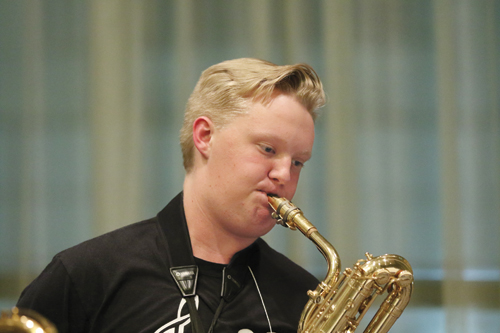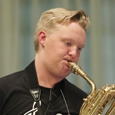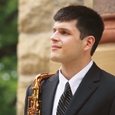
As the repertoire for the saxophone continues to explore more contemporary possibilities, the use of the slap tongue articulation by composers has become increasingly more prevalent. This type of articulation encompasses the open slap, or smack tongue, which produces a loud popping sound, and the closed slap tongue, which produces a more precise, plucking sound. This type of articulation is sometimes difficult to master because of the movements required to produce the effect. Below, three master saxophonists describe the best practices for producing this type of saxophone articulation.
Doug O’Connor
United States Army Band – “Pershing’s Own”
The slap-tongue technique on the saxophone is often of great curiosity to audiences and fellow musicians alike. “What is that sound, and how are you making it?” I am frequently asked after performances that feature slaps.
The slap is an engaged release of the reed, as if one were plucking the reed with the tongue as one would pluck a stringed instrument in pizzicato passages. Of great interest to me is that there are two separate pitches or dimensions to a slap that can be independently controlled: the pitch of the resonance, which is controlled by the fingering on the saxophone, and also the pitch of the percussive sound itself, which can be wet or dry, bright or dark.
Producing any slap requires that the player be able to grab the reed with the tongue, and release it in a sudden enough way that it snaps back to the mouthpiece. The grab can be a pretty foreign and elusive feeling to many players at first, but there are some basic exercises that will help develop the slap.
First, practice on a larger instrument if possible, as it is easier to slap (even by accident) on a bigger reed. To get an initial sense of the grab, try holding a reed on the tongue without the hands or lips; with the right curvature of the tongue, one can fairly easily get enough suction to get a sense of the grab. You can test the tongue’s grip by grabbing the reed with a hand and popping the reed off of the tongue.
Next, try to get the same sense of grab with the reed on the mouthpiece. One might have to use the entire tongue at first to achieve this, despite it being an impractical position for application in performance. From here, one can transition to achieving a slap on the instrument and figuring out how to achieve the grab with less and less tongue on the reed.
At this point it should be noted that there are two basic slap varieties, open and closed. An open slap is a sudden and violent opening of the jaw, exploding off of the reed at the same time. It produces a resonance pitch higher than that of a closed slap, for which the player keeps the mouth closed and the embouchure formed. The closed slap sounds at the fingered pitch. The open slap is often easier, but the closed slap is better for most saxophone repertoire.
One should be able to produce the basic slap with no air at all. I used to practice slapping while inhaling to isolate the slap action from what my airstream might be doing. Working on this helped me realize that a slap is on a continuum with a standard articulation, rather than an extreme and disparate technique. At one extreme, the air acts as a bow on a string, brushing past the reed and coaxing it into vibration. This is like an H attack; there is no tongue at all. One can slowly introduce the tongue, and realize that standard attacks are not attacks at all, but rather delicate releases. A tiny amount of tongue pressure on the reed stops it from vibrating in a supported air stream, and a specific release of that light tongue gives the beginning of a sound clear definition. Gradually increased pressure of the tongue on the reed eventually produces the grab, which requires physically releasing the reed rather than just moving the tongue away from it. In addition, the quality of this particular sound has a full gradient of shadings independent of what the airstream does. Learning to slap helped me realize just how delicate and nuanced a standard articulation really is (for example, even short notes don’t have hard attacks, rather they have sharp cuts).
By listening to Richard Ducros play Jungle by Christian Lauba, I realized that there had to be a way to slap quickly and delicately. What caught my attention was the pitch of the slaps he was getting – they were high, dry, and light. I don’t mean the fingered pitches. In my prior experience, slap was a heavy, tubby thud, impossible to do quickly. Hearing Ducros’s performance was key for me in unlocking a fast slap action. The oral cavity shape can help control the percussive pitch of the slap, in addition to using less tongue. Doing anything fast requires less motion and force. A fast slap is easiest to produce when using a dry, quiet slap and fluid airstream with low resistance, moving the tip of the tongue as little as possible. At this point, the grab can be achieved using the same amount of tongue as a standard articulation, making the two feel interchangeable with no adjustment of the embouchure. This is crucial for passages where alternation is important. Gradient 2.0 (2008), by Baljinder Sekhon II, uses a variety of slaps and hard articulations in alternation, and the result is a satisfying counterpoint of articulations. Such works demonstrate the need for modern players to master the continuum of slap articulations, to execute them proficiently at a variety of tempi, and in a manner that neither disturbs nor intrudes upon their normal mode of playing. The slap tongue expands the saxophone palette in ways both delicate and aggressive, like a whole new set of consonants in our performance language.
Joel Versavaud
Marseilles Conservatory
Translated by Matt Taylor
Saxophonists create the slap using specific muscles on the front and back of the tongue. These allow players to simultaneously trap an air pocket between the tongue and the reed, and then snap the tongue off of the reed toward the back of the mouth. The resulting sound of the rapid decompression of the air trapped on the reed by the tongue is amplified by either the oral cavity or the tube of the instrument.
It is difficult to teach the slap. The movement is hidden, occurs very quickly, and is based on feel. Success depends on the anatomy of the tongue and the amount of regular practice. Musicians who, despite their best efforts, are unable to play slaps must have a fleshy or spongy tongue. The flesh of the tongue may not be dense enough for the muscles to be able to exert the appropriate force.
Patience is necessary. The slap can take a long time to develop, and finally being able to play a slap on the baritone saxophone does not automatically translate to being able to play it on the alto. The wider the reed, the easier the suction effect is to create.
Speed and subtlety come only after regular practice and rest periods. With time, the muscles at the front of the tongue will become just as strong as the back. It is best to choose a piece and a deadline that will require a period of intense practice without discouragement.
These muscles can be stimulated without the saxophone. Clench the jaw, open the lips, and press the entire tip of the tongue against the palate and the upper teeth. While continuing to press with tip of the tongue, quickly move the tongue backwards toward the throat. Chose a high sound and articulate with the tip of the tongue using a syllable like tss then slowly, striving for an intentional and accurate movement, try to create the slap, but just on the highest possible note.
Wind players should work hard to develop independence of the front and back of the tongue, not just for the slap, but to be able to play high notes (back of the tongue) and to articulate them (tip of the tongue). Consider the pronunciation of the word tongue in other languages: langue, lingua, lengua, zunge – the beginning is always pronounced with the tip and the end is pronounced with the back.
Richard Durcos
Bordeaux, France
Translated by Matt Taylor
From unpublished manuscript in press, Resolute Music Publications, Marquette, Michigan. Used with permission.
The slap is a type of attack created by the rebound of the reed hitting against the mouthpiece. It is similar to a Bartok pizzicato on the violin. To create this attack, the tongue acts similarly to a suction cup. Unlike a normal type of articulation, in which the tongue makes contact with the tip of the reed, placing the tongue further down on the reed from the tip creates this attack.
To get the feel of the slap, many saxophonists begin on a low Bb with the open slap, which is cruder and louder, but also much easier to produce. This is basically an articulation for which one presses a maximum amount of the tongue on the reed and opens the mouth simultaneously. The reed produces a dry clack sound similar to the slap.
The disadvantage to learning the slap with this method is that it teaches the wrong reflex of opening the mouth at the same time, which is the opposite of the method for the normal closed slap. The open slap practice should focus on developing an awareness of the timbre created by the clack of the reed and the suction cup feeling of the tongue on the reed. This sensation is the most important part of the slap. Some professors use a spoon in the mouth to help explain this suction cup effect.
Refining the technique to produce a normal slap, or one that is less open, is much more difficult. The sensations are difficult to acquire. The slap is created by a suction cup effect of the tongue on the reed. It is practiced with almost no air because the sound is created by the clack of the reed on the mouthpiece. It is, therefore, unnecessary to inhale or blow air to produce the effect.
One important consideration is the seam created by the lower lip resting over the teeth. To create the suction effect, the tongue has to be applied on the full length of the reed. The air must be expelled over the entire contact surface of the tongue and the reed, but also between the tongue and the space created by the seam of the tongue over the teeth and the reed. The tip of the tongue must be positioned against the seam to seal the place – in other words, the entire tongue pushes on the reed. The lower lip is firm on the teeth. It remains only to articulate; the tip of the tongue stays at the seam of the lower lip. The articulation occurs with the middle to back portion of the tongue.
Rather than trying to get the tongue to stick to the reed by pressing it up, it is possible to slide the tongue forward from the tip of the reed up to the seam of the lip, confirming that it is sticking as it slides down. This method allows for a better sense of the vacuum created by the tongue on the reed
There are numerous viable recommendations for creating this type of articulation. Experimentation and persistence will be the key elements needed for students to create this sound. Also, most saxophonists conclude that starting on a larger saxophone will yield quicker results. Regardless of the techniques used to produce this effect, diligent practice and repetition of the tongue movements needed will ultimately contribute to successful production of the slap tongue.






